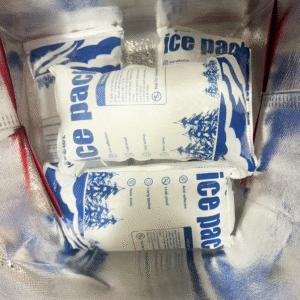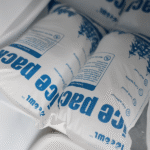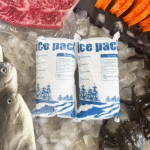Cara mengemas es kering untuk perjalanan udara masuk 2025: A Complete Guide for Safe and Efficient Packing
Packing dry ice for air travel may seem complicated due to the stringent regulations surrounding its transport, Tapi ini adalah proses penting untuk memastikan barang yang peka terhadap suhu, seperti obat -obatan dan barang yang mudah rusak, tetap membeku selama penerbangan. Panduan ini memberi Anda strategi terkini untuk mengangkut es kering dengan aman 2025. Dari kepatuhan peraturan hingga memilih wadah yang tepat, Kami akan memandu Anda langkah demi langkah sehingga Anda dapat memastikan hal yang halus, Perjalanan bebas khawatir untuk barang beku Anda.
-
Peraturan apa yang perlu Anda ikuti saat mengemas es kering?
-
Berapa banyak es kering yang harus Anda bungkus untuk penerbangan?
-
Wadah apa yang terbaik untuk mengangkut es kering di pesawat?
-
Kesalahan umum yang harus dihindari saat terbang dengan es kering.
Cara mengemas es kering dengan aman untuk perjalanan udara?
Packing dry ice for air travel requires meticulous attention to detail to ensure both safety and compliance with airline regulations. Since dry ice sublimates into carbon dioxide (Co₂) gas, it’s classified as a hazardous material. Here’s a complete process to pack it safely:
1. Pilih wadah yang tepat
A proper container ensures that your dry ice remains safely contained while allowing the gas to escape, mencegah penumpukan tekanan. Here’s what to look for in a container:
-
Ventilasi: Your container must have vents or gaps to allow carbon dioxide gas to escape. Without this ventilation, pressure can build up and create dangerous situations.
-
Isolasi: Insulated coolers or boxes are ideal because they prevent dry ice from sublimating too quickly, keeping your contents frozen for longer periods.
-
Daya tahan: The container should be sturdy enough to withstand handling and prevent leaks or damage during transport.
2. Follow Airline Regulations
Each airline has specific rules regarding the transport of dry ice, and it’s essential to comply with them to avoid delays or issues at security checkpoints. Here’s an overview of the regulations:
-
Jumlah es kering: Khas, the FAA allows up to 5.5 pound (2.5 kg) of dry ice in a passenger cabin. Untuk jumlah yang lebih besar, prior approval from the airline is required.
-
Packaging and Labeling: Ensure your container is properly labeled with the words “Dry Ice” and the net weight of the dry ice. Failure to do so can result in rejection at the airport.
-
Declaration Form: If you are carrying more than 5.5 Es kering, you will need to fill out a declaration form that provides information on the amount of dry ice and safety measures taken.
3. Layer Dry Ice and Perishables Correctly
When packing perishable items, it’s important to layer dry ice and your items in a way that maintains a consistent temperature throughout the trip:
-
Place a layer of dry ice at the bottom of the container.
-
Add your perishable items on top of the dry ice.
-
Add another layer of dry ice on top of the perishable goods, ensuring the dry ice surrounds the items evenly.
This layering technique ensures efficient cooling and minimizes the chances of the dry ice sublimating too quickly.
How Much Dry Ice Should You Pack for Air Travel?
The amount of dry ice you need depends on the length of your flight and the types of items you’re transporting. Here are some general guidelines:
-
Short Flights (di bawah 24 jam): 5–10 pounds (2.3–4.5 kg) of dry ice is typically sufficient to keep items frozen.
-
Long Flights (lebih 24 jam): 10–20 pounds (4.5–9kg) of dry ice will likely be needed to keep items frozen for longer durations.
-
Shipping Temperature-Sensitive Items (MISALNYA., Farmasi): Consult the manufacturer or healthcare provider for specific recommendations on the amount of dry ice needed.
It’s important to strike the right balance — too much dry ice could lead to excessive sublimation and too little could cause your items to thaw before they reach their destination.
What Are the Best Containers for Packing Dry Ice?
Choosing the right container for transporting dry ice is vital to maintain safety and temperature control. Let’s explore the best options:
1. Insulated Coolers
These coolers are among the best options for packing dry ice, as they offer excellent insulation and airtight seals. They can withstand rough handling and keep dry ice cold for longer periods.
-
Terbaik untuk: Shipping perishable items like food or medical supplies.
2. Styrofoam Containers
While lightweight, Styrofoam containers offer solid insulation and proper ventilation for the dry ice to sublimate safely. Namun, they may not be as durable as insulated coolers.
-
Terbaik untuk: Small quantities of dry ice (Kurang dari 5 pound) on short trips.
3. Custom Dry Ice Containers
Businesses shipping larger quantities of perishable goods often opt for custom-designed containers that are built for extreme conditions and provide both insulation and ventilation.
-
Terbaik untuk: Pengiriman besar, especially in the cold chain logistics industry.
Common Mistakes to Avoid When Flying with Dry Ice
Even though dry ice can be safely transported, there are some common mistakes that can cause trouble during your flight. Here’s what to avoid:
-
Not Ventilating the Container Properly: Failing to provide proper ventilation can lead to dangerous pressure buildup, so always choose a container that allows CO₂ to escape.
-
Exceeding Airline Limits: Always verify the amount of dry ice allowed by your airline. Exceeding the limit can result in delays or refusal of transport.
-
Using the Wrong Type of Container: Using a non-vented container can cause your dry ice to sublimate too quickly or even damage your perishable items.
2025 Trends in Air Travel and Dry Ice Transportation
The cold chain logistics industry is rapidly evolving, Dan 2025 brings exciting trends that will change the way dry ice is transported. Some key trends to keep an eye on include:
Tren Utama:
-
Kemasan ramah lingkungan: Advances in biodegradable packaging materials are reducing the environmental footprint of transporting dry ice.
-
Advanced Temperature Monitoring: Real-time temperature tracking is becoming more common, allowing shippers to ensure that perishable items stay at the correct temperature.
-
Lebih cepat, More Reliable Shipping: Airlines are investing in faster, more reliable options for transporting temperature-sensitive goods.
These innovations are improving efficiency and safety, making it easier to ship perishable goods via air travel.
Common Questions about Packing Dry Ice for Air Travel
Q1: How do I know if I’ve packed enough dry ice for my flight?
For short flights, 5-10 pounds of dry ice is typically sufficient. Untuk penerbangan yang lebih lama, you may need more. Always factor in the length of the trip and the type of items you’re transporting.
Q2: Can I pack dry ice in my checked luggage?
Ya, dry ice can be packed in checked luggage as long as it is in a vented container and you inform the airline in advance.
Kesimpulan & Rekomendasi
Packing dry ice for air travel requires careful planning to ensure both safety and efficiency. By following the guidelines outlined in this article, you can avoid common mistakes and keep your perishable goods frozen during transport. Always ensure that your container is properly ventilated, berlabel, and compliant with airline regulations.
Langkah selanjutnya:
-
Choose the right insulated, wadah berventilasi.
-
Layer your dry ice and perishables correctly.
-
Inform the airline and fill out any necessary forms.
Tentang tempk
Dan Tempk, we specialize in providing temperature-controlled solutions for air travel. Our range of insulated containers and custom solutions help businesses and individuals transport perishable goods safely. We ensure your items remain frozen and arrive in perfect condition.
Need Expert Advice?
Contact us today for a consultation on the safest ways to ship dry ice for air travel.
























